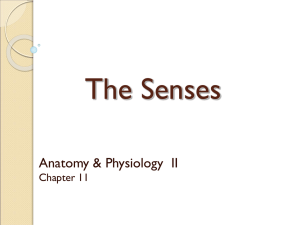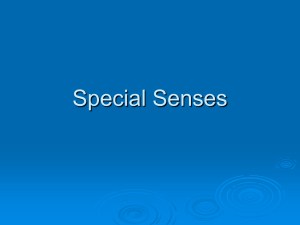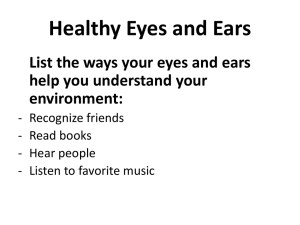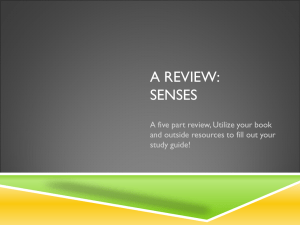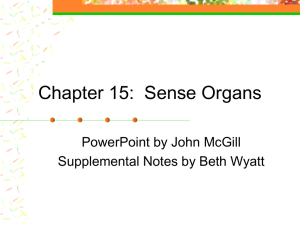PPT13Chapter13SensorySystem
advertisement
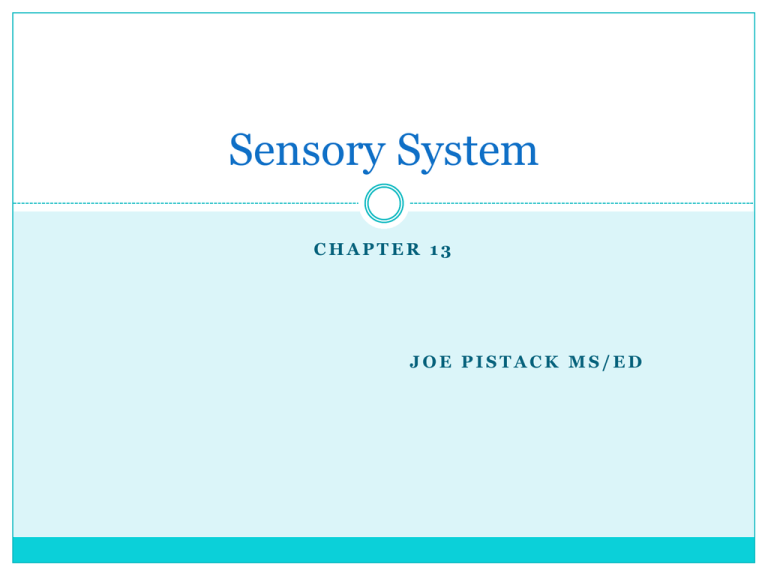
Sensory System CHAPTER 13 JOE PISTACK MS/ED Allows us to experience the world. Sensory System Senses: Seeing We experience the world through our senses. Hearing Feeling Tasting Allows us to keep track of what is happening in our bodies. Acts as a danger signal when we come in contact with a harmful stimulus. Five types of sensory receptors: Cells that detect stimuli Receptor-a specialized area of a sensory neuron that detects a specific stimulus. Chemoreceptors-stimulated by changes in chemicals such as H+, calcium and food. Ex. Taste and smell. Pain receptors or nociceptors Ex. Receptors in the eye respond to light. Ex. Receptors in the tongue respond to chemicals in food. stimulated by tissue damage or distention. Ex. Pain. Thermoreceptors -receptors stimulated by changes in temperature. Ex. Heat and cold Mechanoreceptors-receptors Receptors (continued) stimulated by changes in pressure or movement of body fluids. Ex. Hearing and equilibrium. Photoreceptors-receptors stimulated by light. Ex. Sight. Four components of a sensation: Sensation The conscious awareness of incoming sensory information. Ex. “Ouch”indicates that you are aware of a painful stimulus. (1) Stimulus-light will stimulate sight. Absence of light, you cannot see. (2) Receptor-light waves stimulate photoreceptors in the eye producing a nerve impulse. (3) Sensory nerve-the nerve impulse is conducted to the occipital lobe of the brain. Sensation (continued) Two characteristic s of sensation are: Projection Adaptation Projection-the process by which the brain, after receiving a sensation, refers that sensation back to its source. Ex. Pain Adaptation-adapting to the stimulus. Ex. When you enter a room with a strong odor, it may be overwhelming at first and then become less noticeable. Sensory receptors adapt. Two Groups of Senses General senses: called general or somatic. Widely distributed throughout the body. Special senses: Localized within a particular organ in the head. Include: Include: Pain Taste Touch Smell Pressure Sight Temperature Hearing Proprioception Balance Five Special Senses Five special senses: Smell Taste Sight Hearing balance Pain Pain-receptors for pain, called nociceptors consist of free nerve endings that are stimulated by tissue damage. Pain receptors are widely distributed throughout the skin, the visceral organs, and other internal tissues. Serves a protective function, it Pain motivates the person to remove its cause. Patient’s with diminished pain response are at risk . Diabetic patients have a decreased pain sensation due to nerve damage. They are unable to feel pain in lower extremities. They require meticulous foot care. Referred Pain Referred Pain-when pain feels as if it is coming from an area other than the site where it originates. Ex. Heart pain radiates down arm. Analgesics-drugs to relieve pain. Three pain triggers: Pain Triggers (1) Tissue injury promotes the release of certain chemicals that stimulate pain receptors. (2) A deficiency of oxygen stimulates pain receptors. (3) Pain may be experienced when tissues are stretched or deformed. Mechanoreceptors Touch receptors or tactile receptors are found mostly in the skin. They allow us to feel. Particularly numerous in the lips, fingers, toes, tongue, and external genitalia. Located in the skin, subcutaneous tissue, and deep tissue. Thermoreceptors Two types of thermoreceptors are heat and cold. Found in free nerve endings, and specialized sensory cells beneath the skin. Cold receptors are stimulated between 50 and 76 degrees F and heat receptors are stimulated between 76 and 112 degrees F. Proprioception Sense of orientation or position. Allows you to locate your body part without looking at it. Plays an important role in maintaining posture and coordinating body movement. Proprioception The receptors for proprioception are located in muscles, tendons, and joints. Proprioceptors are also found in the inner ear, where they function in equilibrium. The cerebellum receives sensory information from these receptors. Sense of Smell Olfaction-sense of smell, associated with the sensory structures located in the upper nose. Classified as chemoreceptors, stimulated by chemicals that dissolve in the moisture of the nasal tissue. Sense of Smell The olfactory receptors are stimulated , the sensory impulses travel along the olfactory nerve (CN I). The sensory information is eventually interpreted as smell within the olfactory area of the temporal lobe. Sense of Taste The sense of taste is also called the gustatory sense or gustation. The taste buds are the special organs of taste. Taste receptors are located in the tongue and are classified as chemoreceptors. Sense of Taste Four basic taste sensations: Sweet-tip of the tongue. Salty-near the tip of the tongue. Sour-located in the middle of the tongue. Bitter-back of the tongue. Sense of Sight Vision is one of the most cherished senses. The eyes are the organs of vision. Visual accessory organs assist with function and protecting the eye from injury. Visual Accessory Organs Visual accessory organs include the: Eyebrows Eyelids Conjunctiva Eyelashes Lacrimal apparatus Extrinsic eye muscles Visual Accessory Organs The eyebrows: Patches of hair located above the eyes. Perform a protective role. Keep perspiration out of eyes and shade eyes from glaring sunlight. Participate in facial expression as in the “raised eyebrow look”. Visual Accessory Organs Eyelids: Also called palpebrae. Protect the eyes. Prevent the entrance of foreign objects. Wash tears over the surface of the eye. The medial inner canthus and the lateral outer canthus are the corners of the eye where the upper and lower eyelids meet. Visual Accessory Organs Skeletal muscle opens and closes the eyelids. The muscle that opens the eyelid is called the levator palpebrae superioris, (levator means to raise, like an elevator). The muscle that closes the eyelid is the obicularis oculi. Visual Accessory Organs Conjunctiva-thin mucous membrane that lines the inner surface of the eyelid. The conjunctiva also folds back to cover a portion of the sclera (discussed later) on the anterior surface of the eyeball and is called the white of the eye. Visual Accessory Organs The conjunctiva secretes a substance that moistens the surface of the eye. The anterior surface of the eye must be kept moist or it will ulcerate and scar. The conjunctiva is very vascular. Visual Accessory Organs The “Bloodshot” appearance of the eyes is caused when the blood vessels dilate. Eye drops that get the red out, cause the blood vessels of the conjunctiva to constrict. Conjunctivitis-”pink eye” inflammation of the conjunctiva caused by a bacterial infection. Visual Accessory Organs Eyelashes: Line the edges of the eyelid and help to trap dust. Touching the eyelash stimulates blinking. Sty or hordeolum - infection of the hair follicle caused by staph. Visual Accessory Organs Lacrimal Apparatus: Composed of the lacrimal gland and a series of ducts called tear ducts. The lacrimal gland is located in the upper lateral part of the orbit and secretes tears which flow across the surface toward the nose. Visual Accessory Organs Tears drain through small openings called lacrimal puncta and then into the lacrimal sac and nasolacrimal ducts. The nasolacrimal ducts eventually empty into the nasal cavity. Visual Accessory Organs Normal tears flow to the back of the throat and are swallowed. Increase in tears, as in crying, nose begins to run. Tears perform several functions, moisten, lubricate and cleanse the surface of the eye. Tears contain losozyme which helps destroy pathogens and prevent infection The Eyeball Has a spherical shape and is approximately ¾ to 1 inch in diameter. Most of the eyeball sits within the bony orbital cavity of the skull, partially surrounded by a layer of orbital fat. Composed of three layers: sclera, choroid, and the retina. The Sclera The outermost layer. Made up of tough, fibrous, connective tissue that covers most of the eyeball. Helps contain the contents of the eye. Shapes the eye and is the site of attachment for extrinsic muscles. The Cornea Cornea-transparent extension of the sclera. Covers the area over the iris. Cornea is avascular and transparent, light rays can go through this structure. Called the window of the eye The Cornea The cornea has a rich supply of nerve fibers , sensitive to touch. Corneal reflex-protective function, if the surface of the cornea is touched lightly, causes blinking. The Choroid The Choroid is the middle layer of the eye located between the retina and the sclera. Highly vascular. Attached to the innermost layer of the retina. Extends toward the front of the eyeball to form the ciliary body. The Choroid The ciliary body secretes a fluid called the aqueous humor. Gives rise to the ciliary muscles. Iris-most anterior portion of the choroid, the colored portion of the eye. The Pupil Pupil-opening or hole in the middle of the iris. Pupil size is regulated by two sets of intrinsic muscles located in the iris. Iris regulates the amount of light entering the eye. The Retina Innermost layer of the eyeball. Nervous layer containing visual receptors which are sensitive to light, called photoreceptors. Two types of photoreceptors are rods and cones. The Retina Rods, scattered throughout but most abundant along periphery. Cones, most abundant in the central portion of the retina. Fovea centralis area that contains the highest concentration of cones. The Retina The Optic Nerve forms where the neurons of the retina converge in a small circular area in the back of the eye called the optic disc. Because there are no photoreceptors there, images formed there are not seen by the brain. This area is called the “Blind Spot” The Eye Cavities of the Eye Anterior Cavity Posterior Cavity Located between the Larger and located Lens and Cornea Filled with Aqueous Humor Aqueous Humor helps maintain shape of anterior eye and nourishes the cornea between the Lens and Retina Filled with Vitreous Humor Vitreous Humor pushes on the retina creating good contact with the Choroid ensuring a rich supply of oxygenated blood Eye Muscles Extrinsic eye muscles: Skeletal muscles. Located outside the eye. Move the eyeball in various directions. Eyes move together in a coordinated way. Seeing Light waves enter your eye, are refracted and focused on the photoreceptors of the retina. Photoreceptors of the retina translate light impulses, to a nerve impulse, which is then transmitted from the retina, along the optic nerve to the occipital lobe of the brain. Muscles of the Eye Strabismus: Also called cross-eyed. Eyeballs are not aligned, do not focus on a desired point. Muscles of the Iris Iris contains two muscles: Radial muscle Circular muscle Contraction of the radial muscle causes the pupil to dilate. Contraction of the circular muscle causes pupil to constrict. Mydriasis-sympathetic nerve Mydriasis stimulation that causes pupillary dilation. Mydriatic agents-drugs that cause the pupils to dilate. The Eye Night vision Rods respond to dim light. Provide us with black and white vision. Deficiency of vitamin A can cause night blindness. Day vision Image produced by the stimulation of cones. Three types of cones that produce different colors, green, blue and red. Stimulation of combinations of these colors produces different colors. The Eye Seeing Not seeing Light waves enter your Defect along the eye. Photoreceptors translate light signal to nerve impulses and then transmitted from retina, along optic nerve to occipital lobe. pathway from the cornea to the brain can interfere with vision. Ex. Scarred cornea or cloudy lens may block light. Conditions of the Eye Glaucoma-increased intraocular pressure may squeeze the blood vessels of the choroid, depriving the retina of adequate blood supply. Can lead to blindness. Conditions of the Eye Detached retina-retina falls away from the choroid and it’s blood supply. Macular Degeneration Abilities of the Eye Accommodation- the ability of the lens to change shape in order to focus on close objects Presbyopia- the inability of the lens to change shape in order to focus on close objects Convergence- movement of the eye medially (toward the nose) to stay focused on an object Photopupillary Reflex- When the pupil of the eye changes size to either limit or increase the amount of light entering the eye Refraction- the bending of light rays Consensually- what one pupil does…so does the other Conditions of the Eye Diabetic retinopathy- damage of the retinal blood vessels of diabetic patients. Vessels may develop micro aneurysms which rupture and cause bleeding and scar formation throughout the retina. The Ear Ear is divided into three parts: (1) external ear (2)middle ear (3)inner ear External Ear Part of the ear you can see. Composed of the auricle and the external auditory canal. Auricle or pinna- composed of cartilage covered by a layer of loose fitting skin. The Ear Auricle opens into the external auditory canal. Canal provides a passageway for sound waves to enter the ear. External auditory is hollowed out of the temporal bone. The Ear External auditory canal is about 1 inch long and ½ inch wide and extends to the eardrum (tympanic membrane). Tympanic membrane separates the external ear from the middle ear. The Ear External auditory ear canal is lined with tiny hairs and glands that secrete cerumen. Hairs help prevent dust and foreign objects from entering the ear. Objects inserted to remove cerumen may damage the tympanic membrane. Middle Ear Small air-filled chamber located between the tympanic membrane at one end and a bony wall at the other end. Contains: Tympanic membrane Three tiny bones The eustachian tube Middle Ear Tympanic membrane is composed of connective tissue and has a rich supply of nerves and blood vessels. Tympanic membrane vibrates in response to sound waves that enter the ear through the external auditory canal. Vibration is passed on to tiny bones. Middle Ear Middle ear contains the three tiniest bones in the body: (1)malleus (hammer) (2)Incus (anvil) (3)Stapes (stirrup) The Ear If pressure becomes unequal, tympanic membrane bulges. Membrane streches causing pain. Ex. Pain and pressure in an airplane. Inner Ear Consists of an intricate system of tubes hollowed out of the temporal bone called the bony labyrinth. Inner ear has three parts: (1) vestibule (2) semicircular canals (3) cochlea Inner Ear Cochlea-snail shaped part of the bony labyrinth. Inside the cochlea are the receptors for hearing, they are tiny cells that contain tiny hairs and are called the organ of corti. Hearing Hearing: Sound waves travel through the external auditory canal and hit the tympanic membrane. Vibration causes malleus, incus and stapes to vibrate. Stapes causes the fluid in the inner ear to move. This causes the hairs to bend. Hearing The bending of the hairs triggers the nerve impulse carried by the cochlear branch of the vestibulocochlear nerve, (CN VIII) to the brain. Temporal lobe of the cerebrum interprets the impulse as sound. Equilibrium Receptors for balance are mechanoreceptors. Vestibule contains the receptors that provide information about the position of the head at rest. Semicircular canalas provide information about the position of the body as it moves. Equilibrium Receptors sense changing positions of the head. When position changes the hairs are bent. Receptor cells send nerve impulses to the brain. Brain sends the signal to restore balance.

